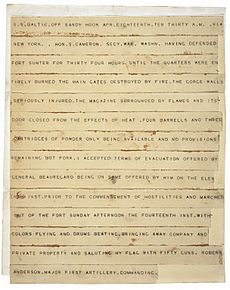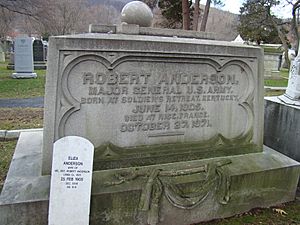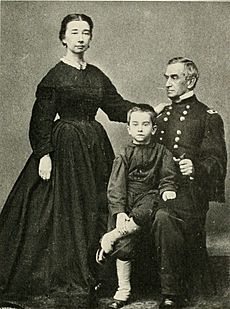Robert Anderson (Civil War) facts for kids
Quick facts for kids
Robert Anderson
|
|
|---|---|
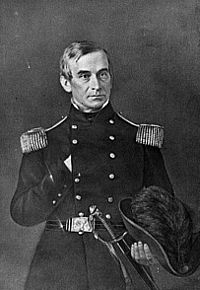 |
|
| Born | June 14, 1805 Louisville, Kentucky, United States |
| Died | October 26, 1871 (aged 66) Nice, France |
| Place of burial |
West Point Cemetery
|
| Allegiance | Union |
| Service/ |
United States Army Union Army |
| Years of service | 1825–1863 |
| Rank | |
| Unit | 3rd Regiment of Artillery 1st Regiment of Artillery |
| Commands held | Fort Sumter Department of the Cumberland Fort Adams |
| Battles/wars | |
Robert Anderson (born June 14, 1805 – died October 26, 1871) was an important officer in the United States Army. He is best known for being the Union commander at Fort Sumter in April 1861. This battle was the very first one of the American Civil War. Confederate forces attacked the fort, and Anderson had to surrender. This event officially started the war. After Fort Sumter, Anderson became a hero in the North. He was promoted to a higher rank and given command of Union troops in Kentucky. He retired from the army in 1863.
Contents
Early Life and Military Training
Robert Anderson was born in Kentucky, near Louisville. His father, Richard Clough Anderson Sr., was a soldier in the American Revolutionary War. He even served with the famous Marquis de Lafayette.
Robert Anderson went to the United States Military Academy (West Point). He graduated in 1825. After graduating, he became a second lieutenant in the 3rd Regiment of Artillery.
Early Military Service
A few months after West Point, Anderson worked for his older brother, who was a US diplomat in Colombia. Later, he fought in the Black Hawk War in 1832. During this war, he twice signed Abraham Lincoln into army service. He also helped transport the captured Native American leader Black Hawk.
In 1833, Anderson returned to the regular army. He served as a first lieutenant in the Second Seminole War. He was promoted to captain in 1841.
Fighting in the Mexican-American War
Anderson also fought in the Mexican–American War (1846-1848). He took part in several battles, including the Siege of Veracruz and the Battle of Molino del Rey. At Molino del Rey, he was badly wounded while attacking enemy forts. Because of his bravery, he was promoted to major.
After his injuries, Anderson was on sick leave for a while. He then worked on creating a new training system for artillery. From 1855 to 1859, he had a lighter duty. He inspected iron beams for government buildings. In 1857, he was permanently promoted to major in the 1st Regiment of Artillery. He also wrote a book about artillery training.
The American Civil War Begins
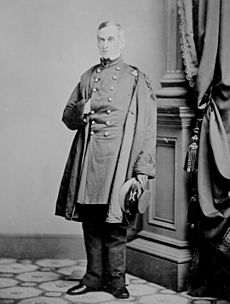
In November 1860, Robert Anderson was put in charge of U.S. forces in Charleston, South Carolina. South Carolina decided to leave the United States in December 1860. Even though Anderson was from Kentucky and had owned enslaved people, he stayed loyal to the Union.
Fort Sumter: The First Battle
Anderson moved his small group of soldiers from Fort Moultrie to Fort Sumter. Fort Moultrie was hard to defend, but Fort Sumter was a stronger fort in the middle of Charleston Harbor. In February 1861, the Confederate States of America was formed. The Confederate President, Jefferson Davis, ordered Fort Sumter to be captured.
The attack on Fort Sumter began on April 12, 1861. Confederate General P. G. T. Beauregard, who had been Anderson's student at West Point, led the attack. Anderson's soldiers were greatly outnumbered and outgunned. He surrendered the fort on April 13. No soldiers were killed during the battle itself. However, one Union soldier died and another was badly wounded during a salute after the surrender. This battle marked the start of the American Civil War.
A National Hero
Robert Anderson's actions at Fort Sumter made him a national hero in the North. He was quickly promoted to brigadier general. Anderson took the fort's 33-star flag with him to New York City. There, he attended a huge patriotic gathering in Union Square, Manhattan. It was the largest public gathering in North America at that time.
The American Flag as a Symbol
Anderson's stand at Fort Sumter changed how people saw the American flag. Before this, the flag was mostly a military symbol. It was shown on special days like the Fourth of July. But after Anderson's brave defense, the flag became a powerful symbol of patriotism.
Historians say that after Fort Sumter, the Stars and Stripes appeared everywhere. It flew from houses, stores, and churches. The flag became a physical symbol of the Union cause. Millions of people would fight and die for it.
Later Assignments and Retirement
After Fort Sumter, Anderson went on a successful tour to recruit soldiers for the Union army. His next job was commanding the Department of Kentucky. Kentucky was a "border state" that tried to stay neutral in the war. Anderson served there from May to October 1861. He then gave up command to General William Tecumseh Sherman. This was partly due to his declining health.
Anderson's last military job was a short time as commander of Fort Adams in Rhode Island in August 1863. He officially retired from the Army on October 27, 1863. This was due to his long service, wounds, and illness. However, he continued to work on the staff of the Eastern Department until 1869. In 1865, he was given the honorary rank of major general for his bravery at Fort Sumter.
After the War
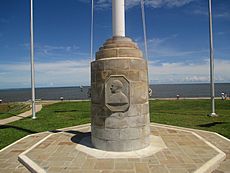
After the Civil War ended, Robert Anderson returned to Charleston. On April 14, 1865, four years after surrendering it, Anderson raised the 33-star flag over Fort Sumter again. It was a moment of triumph. However, just hours after this ceremony, President Lincoln was assassinated.
Anderson died in Nice, France, in 1871. He was buried at West Point Cemetery.
Family Life
Robert Anderson had several notable family members. His brother, Charles Anderson, served as the Governor of Ohio. Another brother, William Marshall Anderson, was an explorer. William's son, Thomas M. Anderson, became a brigadier general and fought in the Spanish–American War.
In 1845, Robert Anderson married Eliza Bayard Clinch. They had five children together.
See also
 In Spanish: Robert Anderson para niños
In Spanish: Robert Anderson para niños


